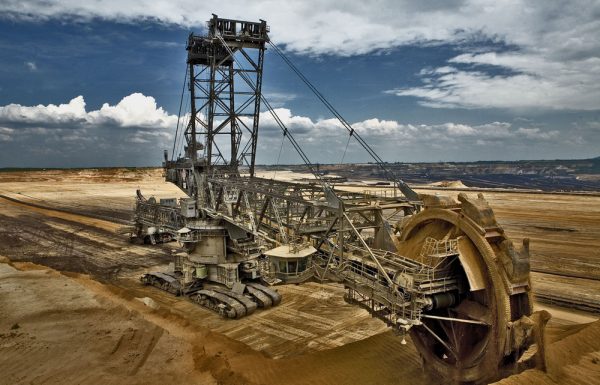Bagger 288 (Excavator 288), built by the German company Krupp for the energy and mining firm Rheinbraun, is a bucket-wheel excavator or mobile strip mining machine.
QUICK INFO
1. It can excavate 240,000 tons of coal DAILY
2. Is up to 220 m long
3. Is approximately 96 m high
4. Requires 16.56 megawatts electricity to operate
5. Travels 2 to 10 m per minute
6. Traveled 22km in 3 weeks
 The Bagger 288 was built for the job of removing overburden before coal mining at the Hambach strip mine in Germany. It can excavate 240,000 tons of coal or 23,240,000 cubic metres of overburden daily[3] – the equivalent of a football field dug to 30 m deep. The coal produced in one day fills 2400 coal wagons. The excavator is up to 220 m long (slightly shorter than Baggers 287 and 293) and approximately 96 m high. The Bagger’s operation requires 16.56 megawatts of externally supplied electricity. It can travel 2 to 10 m per minute (0.1 to 0.6 km/h). The chassis of the main section is 46 m wide and sits on 3 rows of 4 caterpillar track assemblies, each 3.8 m wide. The large surface area of the tracks means the ground pressure of the Bagger 288 is very small (1.71 bar or 24.8 psi); this allows the excavator to travel over gravel, earth, and even grass without leaving a significant track. It has a minimum turning radius of approximately 100 meters and can climb a maximum gradient of 1:18 (5° incline).
The Bagger 288 was built for the job of removing overburden before coal mining at the Hambach strip mine in Germany. It can excavate 240,000 tons of coal or 23,240,000 cubic metres of overburden daily[3] – the equivalent of a football field dug to 30 m deep. The coal produced in one day fills 2400 coal wagons. The excavator is up to 220 m long (slightly shorter than Baggers 287 and 293) and approximately 96 m high. The Bagger’s operation requires 16.56 megawatts of externally supplied electricity. It can travel 2 to 10 m per minute (0.1 to 0.6 km/h). The chassis of the main section is 46 m wide and sits on 3 rows of 4 caterpillar track assemblies, each 3.8 m wide. The large surface area of the tracks means the ground pressure of the Bagger 288 is very small (1.71 bar or 24.8 psi); this allows the excavator to travel over gravel, earth, and even grass without leaving a significant track. It has a minimum turning radius of approximately 100 meters and can climb a maximum gradient of 1:18 (5° incline).
The excavating head itself is 21.6 m in diameter and has 18 buckets each holding 6.6 cubic meters of overburden.
By February 2001, the excavator had completely exposed the coal source at the Tagebau Hambach mine and was no longer needed there. In three weeks it made a 22-kilometer (14 mi) trip to the Tagebau Garzweiler, traveling across Autobahn 61, the river Erft, a railroad line, and several roads. The move cost nearly 15 million German marks and required a team of seventy workers. Rivers were crossed by placing large steel pipes for the water to flow through and providing a smooth surface over the pipes with rocks and gravel. Special grass was seeded to smooth its passage over valuable terrain. Moving Bagger 288 in one piece was more economical than disassembling the excavator and moving it piece by piece.
The Bagger 288 is one of a group of similar-sized and built vehicles, such as Bagger 281 (built-in 1958), Bagger 285 (1975), Bagger 287 (1976), Bagger 293 (1995), etc.
.png)




